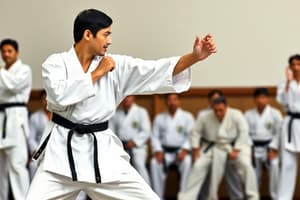Podcast
Questions and Answers
What is the purpose of kata in Shotokan karate?
What is the purpose of kata in Shotokan karate?
- To develop proficiency in striking techniques
- To land accurate strikes against an opponent
- To teach students control, balance, and power (correct)
- To focus on proper footwork and posture
Which of the following is NOT a key principle of Shotokan kumite?
Which of the following is NOT a key principle of Shotokan kumite?
- Proper footwork and posture
- Anticipating opponent's actions
- Landing precise blows on target
- Injuring the opponent (correct)
What is one of the main focuses when practicing Kihon in Shotokan karate?
What is one of the main focuses when practicing Kihon in Shotokan karate?
- Landing high thrusting knife hand strikes
- Wearing protective gear for free fighting
- Executing basic hand strikes with different surfaces of the hand (correct)
- Mastering traditional choreographed sequences
Which kata in Shotokan is often considered one of the highest levels a student may reach?
Which kata in Shotokan is often considered one of the highest levels a student may reach?
In Shotokan karate, what does Kumite refer to?
In Shotokan karate, what does Kumite refer to?
What is the primary purpose of using images in shotokan karate?
What is the primary purpose of using images in shotokan karate?
What is the meaning of the term 'Tsubame Gaeshi' in shotokan karate?
What is the meaning of the term 'Tsubame Gaeshi' in shotokan karate?
Which of the following is NOT a component of shotokan karate?
Which of the following is NOT a component of shotokan karate?
What is the meaning of the term 'Mikazuki Garde' in shotokan karate?
What is the meaning of the term 'Mikazuki Garde' in shotokan karate?
What is the meaning of the term 'Zenkutsu Dachi' in shotokan karate?
What is the meaning of the term 'Zenkutsu Dachi' in shotokan karate?
Flashcards are hidden until you start studying
Study Notes
Shotokan Karate
Shotokan is one of the most popular styles of karate in the world today. It was developed from various Okinawan martial arts under the guidance of Gichin Funakoshi and his son Yoshitaka Funakoshi. Here's a closer look at different aspects of this martial art, including visual representations through images, key language and phrases, kihon, kata, and kumite.
Visual Representation Through Images
Images play a significant role in understanding and practicing shotokan karate. They help illustrate the proper techniques, stances, and movements. For example, photographs can show the correct positioning of hands during punches or the alignment of the body when executing a kick.
 Image credit:Karate Reflexion_.
Image credit:Karate Reflexion_.
Language and Phrases Used in Shotokan
In shotokan karate, certain terms and phrases are used consistently. These terms describe specific techniques, stances, and movements. Here are some common expressions used by practitioners:
- Tsubame Gaeshi - A technique where you block with your palm facing outwards and catch your opponent's attack, turning it back towards them.
- Mikazuki Garde - An advanced guard that involves stepping forward while lifting your arms up and then down in a sweeping motion.
- Zenkutsu Dachi - A front stance where both feet are placed shoulder width apart.
Kihon
Kihon refers to the basic techniques and exercises practiced in shotokan karate. These fundamentals form the foundation for all more complex moves. Some examples of essential kihon techniques include:
- Hijiote, Uchiote, Soto Te - Basic hand strikes using different surfaces of the hand.
- Jodan Mae Geri Tekki Nukite - High thrusting knife hand strike from the fighting stance.
- Uke, Tori, Tai Sabaki - Basic blocking, control, and evasion techniques.
Kata
Shotokan emphasizes mastery of traditional forms known as katas. These choreographed sequences of techniques teach students control, balance, and power. Some well-known shotokan kata include:
- Pinan - Also called Heian in other styles; there are five levels of Pinans, each progressively more challenging.
- Nijushico - A difficult kata often considered one of the highest levels a student may reach.
- Gojushiko - Another advanced kata requiring great skill and strength.
Kumite
Kumite refers to sparring or free fighting in karate. In shotokan, fighters wear protective gear and follow specific rules. The goal is to land accurate strikes against an opponent without causing injury. Key principles of shotokan kumite include:
- Stance - Proper footwork and posture are crucial for balance and stability during combat.
- Timing and Rhythm - Successful kumite requires anticipating your opponent's actions and responding appropriately.
- Control and Precision - Landing precise blows on target is vital for effectiveness.
In conclusion, shotokan karate combines striking techniques, coordination, flexibility, agility, and endurance into a cohesive practice. Through image-based instruction, consistent language use, foundational kihon, diverse kata, and controlled kumite, individuals can develop proficiency in this dynamic martial art style.
Studying That Suits You
Use AI to generate personalized quizzes and flashcards to suit your learning preferences.



